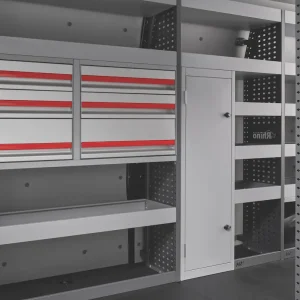
The imposition of the Covid-19 lockdown has meant I’ve not been able to put as many miles on the Blade as I would have wished, but it has nevertheless proven to be an invaluable load-lugger over the past few weeks.
Like many families we have spent a lot of our enforced time at home attempting to get the garden into shape. In our case this means taking up arms against the rampant spread of bamboo plants, which are only slightly less aggressively malevolent than triffids.
So when the local recycling centre reopened, albeit for limited periods only, we were near the front of the queue with the Blade’s load bed brim full with bags of garden waste. Return trips were made with loads of household waste such as old paint cans, plastics and discarded furniture.
Double-cab pick-up trucks boast a go-anywhere ability that can serve them well in carrying a team of workers to inaccessible locations but they suffer in comparison to panel vans when it comes to load volume.
Nevertheless, with careful use of elastic bungee straps, having pulled back the truck’s Mountain Top roll cover (standard on the Blade but a £1,250, ex-VAT extra on lower trim levels) to create more space, I was also able to safely secure a dismantled single bed into the back for a journey home across London. A plus point when loading is that the tailgate employs a gas strut to ensure it opens slowly and gently rather than slamming into the horizontal position, as is often the case with flatbed pick-ups, and risking injury to the operator.
The advantage of having some weight on board is that it takes some of the bounciness out of the D-Max’s ride and makes it more comfortable to negotiate the city’s many speed humps. After all, despite its position at the top of the range, the Blade, like the rest of the D-Max line-up, is at heart a rugged workhorse.
Isuzu’s attempts at installing a sophisticated interior cannot wholly disguise this. The overall result is functional rather than stylish despite the leather upholstery and red stitching. A solid side step makes it easy to get into the cabin, and all the knobs and buttons are clearly positioned and robust, with the exception of the flimsy cover for the USB socket. The driver benefits from easy-to-use steering wheel-mounted controls, and the reversing camera is one of the best I’ve come across.
The Blade comes with keyless entry and a push-button starter, which is not the case with all the models in the flagship D-Max Adventure category – the XTR, for example, requires the driver to put an old-school key into the ignition.
The Blade also gets a full-size spare wheel, which is a must for a vehicle expected to tackle rugged terrain.
Overall, the interior is comfortable enough and a great improvement on previous vintages of the D-Max, let alone its predecessor, the Rodeo, and with the lockdown restrictions gradually easing to allow people to make longer journeys, I decided to take the family for a day trip to the coast in the Blade.
Automatic air-conditioning is a given in contemporary LCVs and efficiently kept the five occupants cool on what was a very hot day, while cruise control helped to make light work of the still relatively empty roads.
The satnav also proved as dependable as ever in getting us to our destination within a quicker than expected hour and a half and is easy to operate via a 9in touchscreen, as is the DAB radio and mobile phone connectivity.
One gripe would be the lack of legroom for the middle passenger in the back.
End of term report
Off-road = 4/5
Copes competently in all conditions
Refinement = 3/5
Lacks the sophistication of some flagship rivals
Cabin = 3/5
Functional rather than stylish
Overall score: 66%
Isuzu D-Max Blade 1.9 Auto
Mileage 11,375
Official combined consumption 36.2mpg
Our average consumption 28.9mpg
Price range (ex VAT). £16,094-£35,334
Price (ex VAT) £29,809
Warranty 5yrs/125,000mls
Service intervals 12,000mls
Load length 1,485mm
Load width (min/max) 1,110/1,530mm
Gross payload 1,101kg
Engine size/power 1,898cc
Gearbox 6-spd auto
CO2 205g/km
Options (ex VAT)
Lazer lights sports bar £810
(See below for previous reports)

In my previous review of What Van?’s long-term D-Max Blade I reported on how the big truck was in its element in coping effortlessly with severe weather conditions, which created challenging driving conditions both on- and off-road.
Since then the Blade has mainly been confined to inner-city assignments, with the occasional jaunt along dual-carriageways and motorways thrown in. While not exactly a fish out of water in urban environments, the Blade can be awkward and cumbersome in certain situations.
Isuzu has always prided itself on the D-Max’s prowess as a capable and rugged working vehicle – it’s heartland is in rural areas, serving the likes of farmers, forestry workers and country vets, and this is reflected in the geographical make-up of the manufacturer’s retail network.
More recently, however, the brand has recognised that in order to increase sales volume it needs to grab a larger slice of the double-cab lifestyle market. It is one of the few pick-up brands (Ford and Toyota are others) that still offers single- and extended-cab trucks, but in the past few years Isuzu has supplemented its D-Max line-up with a procession of special-edition double-cab derivatives, which is how the Blade originated before taking over from the Utah as the top-of-the-range derivative.
This strategy makes sense in principle but could put the D-Max in danger of distancing itself from its core strength as a no-nonsense, competent workhorse.
It also demands that the flagship double-cab models, like the Blade, must face up to being scrutinised against the equivalent versions in rival manufacturer line-ups and run the risk of being found wanting by comparison.
The whole D-Max range is powered by the same 164hp 1.9-litre diesel engine. Although this drivetrain is a lot smoother than the 2.5 unit it replaced three years ago it is less refined than the 213hp 2.0 engine in the Ford Ranger Wildtrak, the 150hp 2.3 in the Mitsubishi L200 or the 163hp or 190hp 2.3 unit in the Nissan Navara, for example.
Nor is the six-speed automatic transmission in our Blade the slickest in town – it may be a close enough match for the auto gearbox in Toyota’s Hilux but is light years away from the eight-speed auto in Volkswagen’s Amarok or the 10-speed set-up in Ford’s Ranger. The drive can be lurchy as the transmission changes up through its cogs and a good deal of whining engine noise encroaches into the cabin.
The D-Max is hardly unique among pick-ups in being prone to understeer but this characteristic feels pronounced when negotiating tight urban streets. Parking can also be something of an ordeal, although it has to be said the task is made easier by sensors and an excellent reversing camera that provides a clear view of the space the vehicle has to squeeze into. The D-Max feels more at home when out on the open road, particularly when bowling along in straight lines as there can be a fair amount of body roll when cornering if you don’t ease off the accelerator.
Report Card: Refinement = 3/5
The Blade lacks the sophistication of some flagship rivals.
Isuzu D-Max Blade 1.9 Auto
Mileage 11,083
Official combined consumption 36.2mpg
Our average consumption 28.4mpg
Price range (ex VAT). £16,094-£35,334
Price (ex VAT) £29,809
Warranty 5yrs/125,000mls
Service intervals 12,000mls
Load length 1,485mm
Load width (min/max) 1,110/1,530mm
Gross payload 1,101kg
Engine size/power 1,898cc
Gearbox 6-spd auto
CO2 205g/km
Options (ex VAT)
Lazer lights sports bar £810
(See below for previous reports)

Hot on the heels of storm Ciara, storm Dennis hit the UK hard, causing further flooding, felling of trees and generally resulting in more of the devastation that leads to treacherous driving conditions.
But the twin tempests did little to knock the newest recruit to What Van?’s fleet, an Isuzu D-Max Blade, out of its stride, even when the weather was at its worst during a cross-country drive with the family from London to Herefordshire.
The Blade is available with a six-speed manual gearbox but I opted for the six-speed auto, which is wedded to the 164hp 1.9-litre engine that is installed in the whole D-Max range.
The transmission comes with three settings: two-wheel drive high for most on-road surfaces, four-wheel drive high for rougher terrain, and four-wheel drive low, which can be engaged with the excellent hill-descent control, for the most demanding assignments.
Despite the wet and windy conditions, when on motorways and A-roads the Blade for the most part coped serenely enough in two-wheel drive mode.
The windscreen wipers offer sufficient speed-adjustment settings to keep vision clear even against driving rain. Sudden gusts of wind, however, do sometimes push the comparatively high-sided vehicle out of its comfort zone, meaning you have to keep a firm grip on the steering wheel, and side-wind assist, which is becoming more common in LCVs, would be a useful addition.
Adaptive cruise control would also be a welcome enhancement to safety and driver comfort with its ability to keep the vehicle a safe distance behind the one in front.
The rivers Severn and Wye are notorious for flooding, and once we ventured into more rural environments I was grateful to be able to switch into four-wheel drive high (via an easy-to-use central dial) to ensure safe passage through the amount of water that rapidly accumulated on B-roads and country lanes.
Our final destination was on higher ground but well off the beaten track and involved traversing steep rocky terrain covered in slippery mud. Once more the Blade coped with the conditions with aplomb when four-wheel drive high was engaged.
The D-Max is, of course, renowned as a rugged workhorse so we expected nothing less than this no-nonsense competence across all surfaces, but in recent years Isuzu has focused on supplementing the line-up, which covers single-, extended- and double-cab formats, with high-end, double-cab versions in a bid to gain a firmer foothold in the lifestyle sector that is dominant in the UK.
Most of these new additions started life as limited editions and the Blade is no exception. It takes its place in the Adventure category of the line-up alongside the more niche hardcore off-road offerings the XTR and the Arctic Trucks conversion, the AT35.
The All Purpose group consists of the Eiger, Yukon and Utah and covers extended-cabs as well as double-cabs, and the entry-level Utility D-Max models include two-wheel drive and single-cab derivatives as well as the other two bodystyles.
Three years ago Isuzu swapped the twin-turbo 2.5-litre diesel engine, producing 163hp and 400Nm torque, with which it launched the D-Max in 2012, for a more refined 1.9 turbo diesel unit delivering 164hp but only 360Nm torque.
While this engine is decent enough it is a little slow off the mark and can be prone to noisy whininess when accelerating through the gears. It does, however, retain the 3.5t towing capacity of its rugged predecessor.
Report Card: Off road = 4/5
The D-Max copes competently in all conditions
Isuzu D-Max Blade 1.9 Auto
Mileage 10,749
Official combined consumption 36.2mpg
Our average consumption 28.4mpg
Price range (ex VAT). £16,094-£35,334
Price (ex VAT) £29,809
Warranty 5yrs/125,000mls
Service intervals 12,000mls
Load length 1,485mm
Load width (min/max) 1,110/1,530mm
Gross payload 1,101kg
Engine size/power 1,898cc
Gearbox 6-spd auto
CO2 205g/km
Options (ex VAT)
Lazer lights sports bar £810





